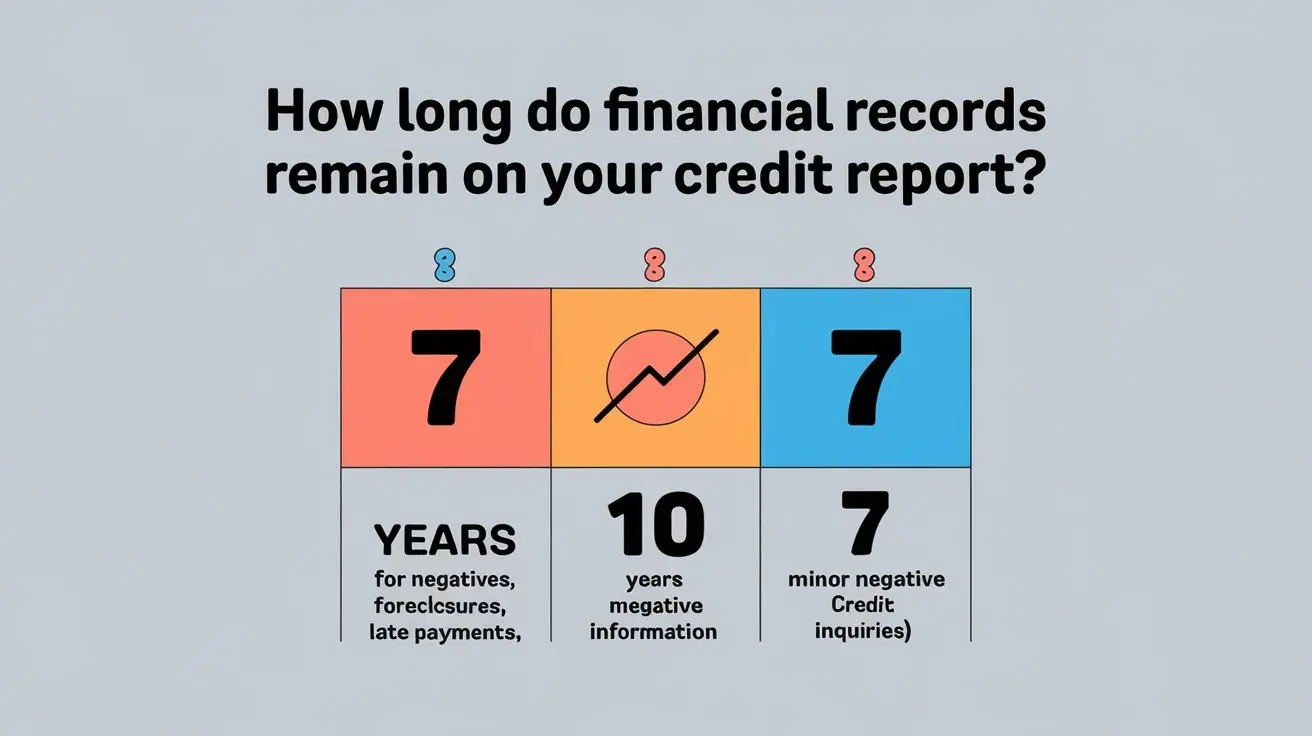-
Posted on: 26 Oct 2024

-
Understanding how long financial records stay on your credit report is crucial for managing your financial health. This guide clarifies the reporting timelines for various accounts, helping you plan for a stronger credit future.
Understanding Credit Reporting: The Basics
Credit reports are detailed summaries of your credit history, compiled by credit bureaus like Equifax, Experian, and TransUnion. Lenders use these reports to assess your creditworthiness when you apply for loans, credit cards, mortgages, and even some rental agreements or insurance policies. The information contained within them is a reflection of how you've managed credit in the past, including payment history, amounts owed, length of credit history, new credit, and credit mix. Understanding the lifecycle of this information is key to effective credit management. In 2025, the landscape of credit reporting continues to evolve, but the fundamental principles of how long information remains visible remain largely consistent, governed by regulations like the Fair Credit Reporting Act (FCRA) in the United States.
The Role of Credit Bureaus
Credit bureaus are central to the credit reporting system. They collect data from various sources, including banks, credit card companies, mortgage lenders, and collection agencies. This data is then organized into individual credit reports. It's important to remember that these bureaus are not lenders; they are information repositories. They are responsible for accurately reporting the information provided to them, and for maintaining that information for specific periods. The accuracy and timeliness of this data directly influence your credit score, a three-digit number that lenders use to quickly gauge your risk level. For instance, a positive payment history on a credit card could remain on your report for up to 10 years, positively influencing your score, while a missed payment might also linger, albeit with a negative impact.
The Fair Credit Reporting Act (FCRA)
The FCRA is a cornerstone of consumer credit rights in the United States. It dictates what information can be included in your credit report, how long certain types of information can remain on it, and your rights to access and dispute inaccuracies. The FCRA sets strict time limits for how long negative information, such as late payments, defaults, and bankruptcies, can be reported. These time limits are designed to prevent past financial mistakes from haunting consumers indefinitely, allowing individuals to rebuild their credit over time. Understanding these FCRA guidelines is the first step in knowing what to expect on your credit report and when certain items will eventually fall off.
What Information is Included?
Your credit report typically includes several key categories of information:
- Personal Information: Name, address, Social Security number, date of birth, and employment history.
- Credit Accounts: Details of your credit cards, loans (mortgages, auto loans, student loans), and other lines of credit. This includes the lender, account number, date opened, credit limit or loan amount, current balance, and payment history.
- Public Records: Information from public sources, such as bankruptcies, liens, and judgments.
- Credit Inquiries: Records of who has accessed your credit report. Hard inquiries (when you apply for credit) can impact your score, while soft inquiries (like checking your own credit) do not.
Each of these categories has specific rules regarding how long they are reported. The duration is often tied to the severity of the information and whether it is considered positive or negative. For example, a positive payment history for a loan will remain visible for a longer period than a minor late payment that was quickly rectified.
How Long Do Different Financial Records Remain on Your Credit Report?
The length of time financial records stay on your credit report varies significantly depending on the type of record and its nature (positive or negative). Understanding these timelines is crucial for financial planning and credit management. Here's a breakdown of common financial records and their reporting periods as of 2025:
Late Payments
Late payments are among the most common negative marks on a credit report. According to the FCRA, a late payment can remain on your credit report for up to seven years from the date of the delinquency. However, the severity of the impact diminishes over time. A payment that is 30 days late will have a less significant negative effect than a payment that is 60 or 90 days late, or one that results in a charge-off.
- 30-day late payment: Typically reported for up to 7 years.
- 60-day late payment: Typically reported for up to 7 years.
- 90-day late or more: Typically reported for up to 7 years.
It's important to note that while the record may remain for seven years, its impact on your credit score will lessen considerably after the first two years, especially if you subsequently maintain a positive payment history.
Charge-Offs and Collections
A charge-off occurs when a lender deems a debt unlikely to be collected and writes it off as a loss. A collection account is opened when the debt is then sent to a third-party collection agency. Both charge-offs and collection accounts are serious negative marks. These can remain on your credit report for up to seven years from the date of the original delinquency that led to the charge-off. Even if you pay off a charged-off debt or a collection account, the record of the charge-off or collection will still remain on your report for the full seven-year period. However, it is often beneficial to settle these debts, as it can be reflected on your report as "paid collection" or "paid charge-off," which is viewed more favorably than an unpaid one.
Bankruptcies
Bankruptcies are the most severe type of negative information that can appear on a credit report. The reporting period varies by the type of bankruptcy:
- Chapter 7 Bankruptcy: Remains on your credit report for up to 10 years from the filing date.
- Chapter 13 Bankruptcy: Typically remains on your credit report for up to 7 years from the filing date. However, some Chapter 13 cases can extend beyond 7 years, and in such instances, the bankruptcy can remain on your report until the case is discharged or dismissed, potentially up to 10 years.
Given their significant impact, it's crucial to understand these timelines for bankruptcy filings. Rebuilding credit after a bankruptcy takes time and consistent responsible financial behavior.
Foreclosures and Repossessions
Similar to late payments and charge-offs, foreclosures and repossessions are serious negative events that can significantly damage your credit score. These typically remain on your credit report for up to seven years from the date of the delinquency that led to the action. A foreclosure indicates a failure to pay a mortgage, while a repossession signifies a failure to pay for an asset like a car. Both are strong indicators of financial distress to lenders.
Judgments and Liens
These are legal actions taken against a consumer for unpaid debts.
- Civil Judgments: Historically, these could remain on a credit report indefinitely. However, under current FCRA interpretations and practices, most civil judgments are removed after seven years from the date they were entered, or after the governing statute of limitations expires, whichever comes first.
- Tax Liens: While tax liens were previously reported indefinitely, recent changes and interpretations mean that most paid tax liens are removed from credit reports after seven years from the date they were paid. Unpaid tax liens may remain longer, but their reporting is also subject to specific rules and statutes.
It's important to verify the exact reporting period with the credit bureaus if you have such items on your report, as specific circumstances and state laws can sometimes influence these timelines.
Credit Inquiries
There are two types of credit inquiries:
- Hard Inquiries: These occur when you apply for new credit (e.g., a credit card, loan, or mortgage). Each hard inquiry can have a small, temporary negative impact on your credit score. Hard inquiries remain on your credit report for up to two years, but they generally only affect your credit score for the first year.
- Soft Inquiries: These occur when your credit is checked for pre-approval offers, by existing creditors, or when you check your own credit report. Soft inquiries do not affect your credit score and typically remain on your report for up to two years, but they are usually only visible to you.
Managing the number of hard inquiries is a key aspect of maintaining a healthy credit profile.
Closed Accounts
The reporting of closed accounts depends on whether they were closed by you or the creditor, and whether they were in good standing or had negative marks.
- Positive Closed Accounts: If you close an account that was in good standing (e.g., you paid off a credit card and closed it), the account and its positive payment history will typically remain on your credit report for up to 10 years from the date of closure. This is beneficial as it contributes to your credit history length and positive payment record.
- Negative Closed Accounts: If an account was closed due to delinquency or default, the negative information (late payments, charge-offs) associated with it will remain on your report for the standard period, usually seven years from the original delinquency date.
The reporting of closed accounts is crucial for understanding how your credit history is presented. Even after closing an account, its history can continue to influence your credit score.
Positive Payment History
Positive payment history is the most important factor in building a good credit score. A history of on-time payments on loans and credit cards is invaluable. Fortunately, positive information can remain on your credit report for a long time. While specific account details might eventually be removed after a certain period (often 10 years for well-managed accounts), the overall positive impact on your credit history continues to be recognized by scoring models. The general rule is that accounts in good standing, even if closed, can be reported for up to 10 years from the date of last activity or closure. This long-term reporting helps demonstrate a consistent track record of responsible credit management.
Credit Limit Information
Credit limit information for open accounts is generally updated regularly by the creditor. For closed accounts, the credit limit at the time of closure may be reported. This information is important for calculating your credit utilization ratio, a key component of your credit score. There isn't a specific "removal" date for credit limit information itself, as it's tied to the account's reporting period. However, the impact of the credit limit on your utilization ratio is ongoing as long as the account is reported.
Type of Record Reporting Period (from original delinquency/event date) Impact on Credit Score Late Payments (30, 60, 90+ days) Up to 7 years Negative, impact decreases over time Charge-Offs Up to 7 years Significantly Negative Collection Accounts Up to 7 years Significantly Negative Chapter 7 Bankruptcy Up to 10 years Severely Negative Chapter 13 Bankruptcy Up to 7 years (or case discharge, max 10 years) Severely Negative Foreclosures Up to 7 years Significantly Negative Repossessions Up to 7 years Significantly Negative Judgments (Civil) Up to 7 years (from entry) Significantly Negative Tax Liens (Paid) Up to 7 years (from payment date) Negative Hard Inquiries Up to 2 years (impacts score for ~1 year) Slight, temporary negative Closed Accounts (Good Standing) Up to 10 years (from closure/last activity) Positive, contributes to history length Factors That Can Affect Reporting Time
While the FCRA sets general guidelines for how long financial records remain on your credit report, several factors can influence these timelines or how they are applied in practice. Understanding these nuances is important for accurately assessing your credit report and planning your financial strategy.
The Date of First Delinquency
This is the most critical date for determining how long negative information stays on your report. For most negative items like late payments, charge-offs, repossessions, and foreclosures, the seven-year clock starts ticking from the date of the *first delinquency* that led to the negative status. It does not reset if the account is sold to a collection agency or if you make a partial payment. For bankruptcies, the clock starts from the filing date.
Example: If you missed a payment on a credit card in January 2020, and it eventually went to collections in March 2020, the seven-year period for that delinquency typically starts from January 2020, meaning it would fall off your report around January 2027.
Payment or Resolution of Debt
Paying off a collection account or a charged-off debt does not remove the record from your credit report before the reporting period expires. The FCRA mandates that the original delinquency date determines the removal date. However, marking a debt as "paid" or "settled" is beneficial. A "paid collection" is viewed more favorably by lenders than an unpaid one. While the negative event still remains for its designated period, demonstrating that you've resolved your obligations can mitigate some of the negative impact on your credit score.
Statute of Limitations
The statute of limitations is a law that sets the maximum time after an event within which legal proceedings may be initiated. While the FCRA governs how long information stays on a credit report, the statute of limitations affects how long a creditor can sue you for an unpaid debt. This is different from the reporting period on your credit report. For instance, a debt might be too old for a creditor to sue you in court, but the record of that debt can still appear on your credit report for its full reporting period.
Errors and Disputes
If you find an error on your credit report, you have the right to dispute it with the credit bureaus and the furnisher of the information (the company that reported it). If an investigation confirms the error, it must be corrected or removed from your report. This can sometimes lead to the removal of an item before its scheduled reporting period expires. It is essential to regularly review your credit reports for accuracy. In 2025, consumers have more tools than ever to monitor their credit and initiate disputes.
Re-aging of Accounts
"Re-aging" is a prohibited practice where a creditor falsely represents that a debt is currently due or that the statute of limitations has not expired. This can happen if a creditor applies a payment to an older debt incorrectly, effectively resetting the delinquency date. Consumers should be aware of this and dispute any instances of re-aging they discover. The FCRA and other consumer protection laws are designed to prevent this.
New Activity on Old Accounts
If you make a payment or acknowledge a debt that is past its statute of limitations for legal action, it can sometimes revive the debt, potentially allowing a creditor to sue you. However, for credit reporting purposes, the original delinquency date usually still dictates the removal date. The key is that making a payment on a delinquent account generally does *not* reset the seven-year reporting period for that delinquency. The reporting period is tied to the original date of default.
State Laws
While the FCRA provides a federal framework, some states may have laws that offer additional consumer protections or slightly different rules regarding debt collection or reporting periods for certain types of judgments or liens. It's always advisable to be aware of any specific state laws that might apply to your situation.
The Impact of These Records on Your Credit Score
The presence and age of financial records on your credit report significantly influence your credit score. Lenders use scoring models (like FICO and VantageScore) that weigh different factors differently. While the exact algorithms are proprietary, the general impact of various records is well-understood.
Payment History (35% of FICO Score)
This is the most critical factor. On-time payments contribute positively, while late payments, charge-offs, and collections contribute negatively. The severity and recency of negative payment history have the most significant impact. A 30-day late payment from two years ago will have less impact than a 90-day late payment from six months ago. Records that are older and less severe have a diminishing negative effect over time.
Amounts Owed / Credit Utilization (30% of FICO Score)
This refers to the amount of credit you are using compared to your total available credit. High credit utilization ratios (using a large percentage of your available credit) negatively impact your score. While the reporting period of a specific debt is relevant for its overall presence, the current balance and credit limit are what influence utilization. Even if a debt is nearing its removal date, a high current balance will still hurt your score.
Length of Credit History (15% of FICO Score)
A longer credit history generally leads to a better score, assuming it's a history of responsible credit use. Older accounts, especially those in good standing that are still being reported (even if closed), contribute positively to this factor. This is why closing old, unused credit cards with no annual fees can sometimes negatively impact your score by reducing your average age of accounts and available credit.
Credit Mix (10% of FICO Score)
Having a mix of different types of credit (e.g., credit cards, installment loans like mortgages or auto loans) can be beneficial. This factor weighs how well you manage different forms of credit. The reporting period of these accounts contributes to the overall picture of your credit mix over time.
New Credit (10% of FICO Score)
Opening many new accounts in a short period, or having multiple hard inquiries, can lower your score. This is because it can signal increased risk. The impact of hard inquiries is temporary, typically lasting for about a year, even though they remain on your report for two years.
Diminishing Impact of Older Records
As financial records age, their negative impact on your credit score generally decreases. A 30-day late payment from seven years ago will have a negligible impact compared to one from six months ago. Similarly, a bankruptcy that is nearing its 10-year mark will have less of a detrimental effect than one that is recent. Scoring models are designed to prioritize recent behavior. This is why consistent positive behavior after a negative event is crucial for rebuilding your credit.
The "Fresh Start" Principle
The FCRA's reporting time limits are based on the idea of a "fresh start." After a certain period, past financial mistakes are no longer considered as relevant to your current creditworthiness. This allows individuals to rebuild their credit and qualify for financial products again. However, the longer and more severe the negative event, the longer it may take for your credit score to recover fully, even after the item is removed.
Strategies for Managing Old Records and Improving Your Credit
While you cannot typically remove accurate negative information from your credit report before its scheduled removal date, there are proactive strategies you can employ to manage the impact of older records and improve your overall credit health. Focusing on these steps can significantly boost your credit score over time.
1. Obtain and Review Your Credit Reports Regularly
Your first step is to know what's on your report. You are entitled to a free credit report from each of the three major credit bureaus (Equifax, Experian, TransUnion) every 12 months through AnnualCreditReport.com. In 2025, many services also offer more frequent access.
- Check for accuracy: Look for any errors, such as accounts you don't recognize, incorrect balances, or incorrect delinquency dates.
- Identify removal dates: Note when older negative items are scheduled to fall off your report.
- Monitor progress: Track how your score changes as older items age or are removed.
2. Dispute Inaccuracies Promptly
If you find any errors, dispute them immediately with both the credit bureau and the creditor that reported the information. The FCRA requires credit bureaus to investigate disputes within a reasonable time (typically 30 days). If an error is confirmed, it must be corrected or removed. This is the only legitimate way to get an accurate item removed early.
3. Focus on Current Positive Behavior
Since older negative items have a diminishing impact, your current financial habits are paramount.
- Pay all bills on time: This is the most crucial factor for your credit score. Set up automatic payments or reminders to ensure you never miss a due date.
- Keep credit utilization low: Aim to use no more than 30% of your available credit, and ideally less than 10%. Pay down balances whenever possible.
- Avoid opening unnecessary new credit: Limit applications for new credit, as multiple hard inquiries can temporarily lower your score.
4. Settle or Pay Off Old Debts (Strategically)
While paying off a collection or charge-off won't remove the record early, it can improve your creditworthiness.
- Negotiate: If you have outstanding collection accounts, you may be able to negotiate a settlement for less than the full amount owed.
- Get it in writing: Always get any settlement agreement in writing before making a payment.
- Update your report: Ensure the updated status (e.g., "paid collection") is reflected on your credit report.
5. Maintain Older, Positive Accounts
Accounts that have been in good standing for a long time, even if closed, can contribute positively to your credit history length and overall credit mix. Avoid closing them if they don't have annual fees, as this can shorten your average age of accounts and reduce your available credit, potentially lowering your score.
6. Consider a Secured Credit Card or Credit-Builder Loan
If your credit is damaged, these tools can help you build a new positive credit history.
- Secured Credit Card: Requires a cash deposit that usually equals your credit limit. Use it responsibly for everyday purchases and pay it off in full each month.
- Credit-Builder Loan: You make payments on a loan that is held in an account until you've paid it off. The payments are reported to credit bureaus.
7. Be Patient
Credit repair takes time. The most effective strategy is consistent, responsible financial behavior. As accurate negative items age and eventually fall off your report, and as you build a new positive history, your credit score will naturally improve.
Common Misconceptions About Credit Report Timelines
The rules surrounding credit reporting can be complex, leading to several common misunderstandings about how long financial records remain on your credit report and how they affect your score. Clarifying these misconceptions is vital for accurate credit management.
Misconception 1: Paying off a collection account removes it from my report.
Reality: As discussed, paying off a collection account or a charged-off debt does not remove the record from your credit report before its scheduled removal date (typically seven years from the original delinquency). The record of the delinquency will remain. However, it will be updated to show as "paid," which is generally viewed more favorably by lenders than an unpaid collection. The impact of the negative event still persists for its full reporting duration.
Misconception 2: The seven-year clock resets if I make a payment.
Reality: This is generally not true for accurate reporting under the FCRA. The reporting period for most negative information begins from the date of the *first delinquency*. Making a payment on an account that is already delinquent does not reset this clock. If a creditor attempts to "re-age" an account by incorrectly applying payments to reset the delinquency date, this is a violation of consumer protection laws, and you should dispute it.
Misconception 3: All negative information falls off after seven years.
Reality: While seven years is a common reporting period for many negative items (late payments, charge-offs, repossessions), some items, most notably bankruptcies, have longer reporting periods. Chapter 7 bankruptcies can remain for up to 10 years, and Chapter 13 bankruptcies can also extend up to 10 years depending on the case duration. Also, positive information from well-managed accounts can remain for up to 10 years after closure.
Misconception 4: Credit report information is removed exactly on the day it hits the seven- or ten-year mark.
Reality: While there are strict guidelines, the exact removal date can sometimes vary slightly. It's generally removed shortly after the seven- or ten-year mark from the original delinquency or filing date. It's also important to note that some older data might be purged by credit bureaus periodically, but you should not rely on this. The FCRA mandates a maximum reporting period.
Misconception 5: You can pay a fee to have negative items removed.
Reality: Legitimate credit repair companies can help you dispute errors or negotiate with creditors, but they cannot legally remove accurate negative information from your credit report before its time. Be wary of any company that guarantees removal of accurate negative information for a fee, as this is often a scam. Your only recourse for removing accurate negative information is to wait for the reporting period to expire.
Misconception 6: Inquiries stay on your report forever.
Reality: Hard inquiries, which occur when you apply for credit, remain on your credit report for up to two years. However, their impact on your credit score typically diminishes significantly after the first year and often has no impact after 12 months.
Misconception 7: Old, paid-off debts are always better removed.
Reality: If an old debt was paid off in full and in good standing, its continued reporting (often up to 10 years for positive accounts) is beneficial. It demonstrates a long history of responsible credit management. The key is the status of the account. A negative item that has aged and is nearing its removal date is different from a positive account that is still contributing to your credit history length.
Conclusion: Taking Control of Your Credit Future
Understanding how long financial records remain on your credit report is fundamental to effective credit management. As we've explored, most negative information, such as late payments, charge-offs, and repossessions, typically stays on your report for up to seven years from the date of the original delinquency. More severe issues like bankruptcies can remain for up to ten years. Positive information, like on-time payments on well-managed accounts, can stay even longer, contributing to a robust credit history. While you cannot remove accurate negative information prematurely, your focus should be on consistent positive financial behavior. Regularly monitoring your credit reports for accuracy, paying all your bills on time, keeping credit utilization low, and being patient are the most powerful strategies for improving your credit score. By staying informed and proactive, you can effectively navigate the complexities of credit reporting and build a stronger financial future.











